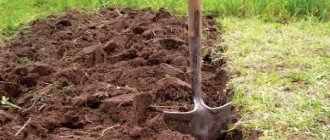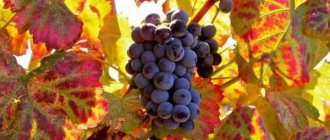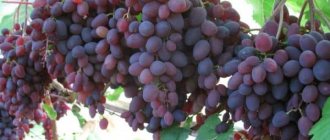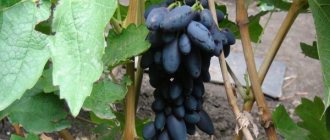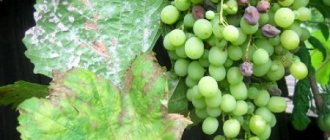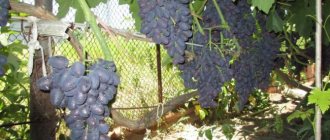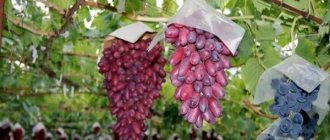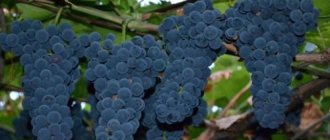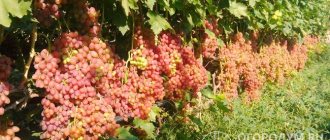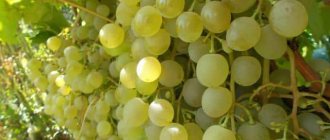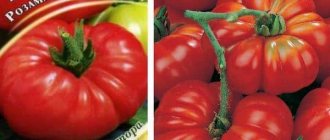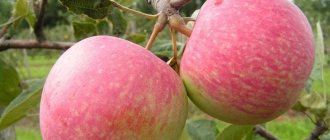Advantages and disadvantages
The Marquette variety, like most breeding forms of grapes, has some advantages and disadvantages.
The main advantages of “Marquette” include:
- Frost resistance.
- High yield.
- Resistance to fungal diseases and pests.
- Good berry taste.
- Easy to care for.
The variety is also characterized by a high degree of seedling survival and vertical bush growth, which allows you to spend less time caring for the plant.
Despite the numerous advantages of the variety, it also has disadvantages, including:
- Poor tolerance of adverse weather conditions by young seedlings.
- Possibility of purchasing high-quality planting material only from licensed suppliers.
In addition, buds bloom early on the bushes, so young shoots can die even with seemingly insignificant spring frosts of -3 °C.
Protection from diseases and pests
Marquette grapes are considered resistant to diseases (especially fungal types) and pests, but this effect is achieved mainly through strict adherence to agricultural practices. If a gardener makes mistakes, the plant's immune system weakens, making the grapes susceptible to disease.
If you are growing a variety recently, pay attention to the following aspects:
- The leaves should have a uniform light green color and should not have any plaque on them. If yellowish spots or a gray coating forms, treat all bushes with antifungal agents. Be sure to remove affected items.
- Spray fruiting plants with a weak solution of potassium permanganate or a liquid of water and soda.
- To prevent birds from pecking the berries, provide the bunches with a special net.
- To prevent wasps from attacking the berries, be sure to install traps with a sweet mixture in the vineyard (you can use honey water).
Removing excess shoots and top roots
A prerequisite for caring for Marquette grapes is the removal of the top roots, which are located in the surface layer of the earth. This will allow the root system to branch deeper.
The same is done with excess shoots - they are cut off, selecting weak elements. If this is not done, then you will not be able to reap a good harvest, since the bush must contain one, but very strong shoot.
Origin
The Marquette grape was developed at the University of Minnesota in 1994, but work to find a suitable parent pair began in 1989.
Breeders Peter Hemstad and Jim Luby crossed 8 different varieties , the latest being Ravat 262 and the complex hybrid crop MN 1094. In 1989 they managed to obtain hybrid seeds, and in 1994 a seedling was selected that gave birth to a new variety, which was initially assigned the code MN 1211.
After successful testing in 2005, the variety was patented and named “Marquette” in honor of the French explorer of North America and Christian preacher Jacques Marquette.
History of variety selection
Marquette grapes belong to technical interspecific hybrids. Scientists from Minnesota have developed a variety that is amazing in its characteristics. This happened in 1989, the plant was patented in 2006. Breeders crossed the varieties Rava 262 and MS 1094, which led to the creation of new grapes with stable immunity to low temperatures and crop diseases. In addition, wines made from the Marquette variety are distinguished by excellent taste, color, and quality. The grape was assigned the code MN 1211.
Main characteristics
“Marquette” is a rather young technical grape variety that has managed to establish itself on the positive side. The berries can be eaten fresh or used to make high-quality wines.
Maturation period and class
“Marquette” is a medium-early ripening grape variety ; the growing season from the moment the buds open until the crop is ready for harvest lasts 125-130 days. Depending on the growing region, the fruits reach removable maturity in the second half of August or early September.
Bush
The bushes are distinguished by fairly high growth vigor. Young shoots have closed crowns with weak pubescence.
Abundant harvest of Marquette grapes on the arch
The leaves are medium in size, round in shape, three- or five-lobed with weak dissection, serrated edges. The surface of the leaf blades is smooth, dark green, and the veins are light. The petiole recess is open, vaulted with a sharp bottom or lancet. The petioles are long, green at the base and anthocyanin closer to the leaf.
The flowers are bisexual, so no additional pollination is required.
A distinctive feature of the “Marketta” bushes is the vertical growth of shoots. Thanks to this, sunlight is distributed evenly across the bushes, and the vine practically does not need to be pruned or tied up.
Bunches and berries
After flowering, 2, rarely 3, medium-sized clusters of conical or cylindrical-conical shape are formed on each shoot, the length of which is 10-11 cm, and the weight is 200-400 g. They are moderately dense or loose in structure.
Reference! In case of unfavorable weather conditions during flowering, the clusters may be excessively loose.
The berries are small, round in shape, reach 12-14 mm in diameter and weigh 1.1-1.2 g, covered with a thin but quite durable skin of a dark blue, almost black color with a thin layer of bluish waxy coating.
The flesh is light pink in color and there are several small seeds inside.
The fruits contain 25-28% sugar and 2.9% acid.
Taste and yield
Sweet and harmonious, without bright varietal shades.
With proper plant care, the yield of the “Marquette” variety reaches 90-100 c/ha.
Trimming
Over a three-year period, caring for Marquette grapes involves timely feeding and watering. However, next you need to deal with pruning and shaping the Marquette grape bushes. Unpruned grape bushes grow very quickly, forming dense thickets. Pruning creates favorable conditions for its development, increases the illumination of the bunches and their aeration.
At the beginning of summer, the grapes are “dry gartered”, with the help of which the growth of the vine is directed. Last year's shoots are tied to the trellis after the end of spring frosts. For the southern regions, the optimal time for the procedure is April, when fresh branches have not yet had time to grow. In the Moscow region, “dry gartering of Marquette grapes is carried out in June.
The next operation is to break off the branches, which is carried out with the buds opening. It consists of:
- in pruning barren shoots growing at the base of the vine;
- removing excess shoots of the Marquette variety appearing from one eye;
- breaking off weak and difficult-to-grow branches.
Around the end of June, shoots need to be pinched. To provide more nutrition to the grape clusters, the shoots on the fruit-bearing vine must be shortened by cutting off their tops. Marquette bushes should be pruned, leaving 5 leaves after the second brush. At the same time, you need to pinch the top of the vine so that it does not stretch too much. You should not remove all fruitless shoots of grapes, as they form a supply of nutrition.
Comparison with analogues
Next, let’s compare “Marquette” with the main varieties similar to it.
| Sign | Variety | ||||
| Marquette | Augusta | Taiga | Alievsky | Alpha | |
| Ripening period | 125-130 days | 128-130 days | 90-100 days | 130-135 days | 110-145 days |
| Frost resistance | Up to -38 °C | Up to -25 °C | Up to -32 °C | Up to -26-28 °C | Up to -35 °C |
| Productivity | 90-100 c/ha | 100-110 c/ha | Up to 100 kg/bush | 130-140 c/ha | 150-180 c/ha |
| Bunches | 200-400 g | 110-120 g | 120-140 g | 120-130 g | 150-250 g |
| Taste | Sweet | Sweet and sour with a hint of nutmeg | Sweet and sour | Without features | Sour |
| Color | Dark blue, almost black | Dark blue | From dark blue to black | Blue-black | Red-brown or purple |
| Disease resistance | High | Average | High | Average | Average |
| Shelf life | A few months | Few weeks | Up to 3 months on the bush | Few weeks | Up to 1 month |
| Sugar content | 25-28% | 22-23% | 18-20% | 18-20% | 15-16% |
| Acidity | 2.9 g/l | 7-9 g/l | 7-9 g/l | 7-8 g/l | 10-11 g/l |
Reproduction of the variety, how and when to do it
The Marquette variety is most successfully propagated by cuttings. To do this, in the fall, the strongest vines are cut into cuttings.
Prepared material:
- soak in water for a day (one end of the cutting is placed in 1.5-2 cm of water);
- etched with a solution of copper sulfate;
- dried;
- sent for storage.
Important! Planting takes place next spring, as soon as weather permits. Approximately once every 2 months, the planting material is inspected, removing damaged, rotten or dried cuttings.
Application and beneficial properties
100 g of fruit contains approximately 0.6 g of proteins, fats and ash, 15.5 g of carbohydrates, as well as vitamins A, C, group B, carotene, tocopherol, riboflavin, thiamine.
Semi-sweet and dessert wines with a deep and rich ruby color are made from the fruits of the Marquette grapes.
The taste of wine made from these grapes has notes of black cherry, blackberry, plum, dark chocolate, black pepper and other spices. There is also a smell of tobacco and leather.
Reference! The strength of the wine reaches 15%; it can be reduced by mixing Marquette with a less sweet variety.
External description of Marquette grapes
The complex grape variety does not shine with its beauty, since its breeding was pursued for technical purposes. But since the grape culture itself is attractive, it looks great on a personal plot.
One of the interesting things about grapes is that they grow vertically. This idea of the breeders allows the sun to do its job. Direct light exposure not only affects the quality and taste of berries, but also has a positive effect on their color. The clusters are not densely scattered and are slightly hidden behind the foliage.
Medium-sized brushes have a canonical shape. Dark berries with a protective coating fit tightly to their base. Their color is very rich, blue or black-violet. The berries are round, and the overall bunch looks like regular wine grapes. Confirmation of this can be seen in the photo of Marquette grapes, which are attached to the article.
Features of cultivation
To get a high-quality and abundant harvest, it is necessary to plant the seedlings correctly and provide the bushes with proper care in compliance with all agrotechnical requirements.
Landing
You can plant grapes on the site in spring or autumn. If we are talking about annual seedlings rooted last season, then it is better to plant them in late April-early May, and green seedlings can be planted from late May to late June. Favorable time for autumn planting is late September-early October.
Marketta bushes love good light and warmth, so they should be planted on the south side of the site. It is better to choose elevated locations to minimize the likelihood of moisture stagnation and waterlogging of the soil, and ensure that the groundwater depth is at least 2.5 m, otherwise drainage will be required.
The variety prefers loose soil with good moisture permeability and aeration, ideally sandstone and loam, otherwise the soil will need to be dug up with compost. Read a separate article about ideal soil for grapes.
Watering and fertilizing
Marquette grape bushes do not need too frequent watering - in favorable weather conditions and sufficient rainfall, it is enough to water the plants once a month (except for the flowering period), using water heated in the sun to +15-20 °C. Watering is especially important during bud break, before flowering and after leaf shedding.
In the spring you need to feed grapes with mineral fertilizers containing phosphorus and nitrogen, or a solution of manure. In summer, especially during the formation of ovaries and ripening of bunches, bushes need phosphorus and potassium. Compost should be spread under the bushes twice a year.
Reference! The root system of these bushes can only absorb liquid fertilizers, so they all must be water-soluble.
Trimming
You can trim only bushes that have reached 3 years old - this will increase the light and aeration of the bunches.
In the spring, it is necessary to carry out a “dry garter”, tying last year’s shoots to the trellis, when there is no threat of spring frosts. The optimal time for this in the southern regions is April, in the Moscow region - June.
You also need to remove excess shoots, leaving 35-40 buds on the bush and pinch the top of the vine to avoid excessive stretching. Nutrients accumulate in barren shoots, so they should not be removed all.
Diseases and pests
The variety is highly resistant to powdery and downy mildew, blackleg and gray rot, even under conditions of frequent and prolonged rains and a sharp drop in temperature. In rare cases, bushes can be affected by phylloxera.
Reference! "Marquette" tolerates chemical treatment well, so preventive spraying of the bushes should not be neglected.
Frost resistance
“Marquette” is a non-covering variety and can easily tolerate frosts down to -38 °C, as well as winter temperature changes. At the same time, the vine is susceptible to freezing in spring even with a slight cooling down to -3 °C.
Harvest storage
Harvesting should be done using sharp scissors or pruning shears and stored in wooden boxes in a dark room at a temperature of +3-10 °C. You can also hang the bunches on a wire, making sure that they do not touch. In such conditions, the berries can be stored for several months.
Regions
Due to the high degree of frost resistance of the bushes and their ability to adapt to climatic conditions, the variety can be successfully cultivated in any area. Thus, grapes grow well even in the northern or northwestern regions and in the Moscow region.
Useful tips
Be sure to follow the recommendations of experienced winegrowers, which will help you avoid many problems when growing Marquette grapes:
- The variety loves a lot of light and air, so do not ignore the rules for pruning shoots and thinning foliage.
- Select the site correctly - it is better to plant the seedlings on a hill where there is no nearby groundwater (this will prevent the roots from getting wet).
- Be sure to protect young plants in the spring from frost and cold, wet precipitation.
- Loosen regularly to ensure oxygen supply to the root system.
- In the spring, treat all bushes with fungicidal preparations to protect against diseases. Read more about this here.
- Monitor the soil moisture level until fruit begins to form.
- Remove weeds that feed on nutrients.
- Carry out mulching and pruning.
Reviews
A good late ripening hybrid. Bogdan, Lviv
There's some pretty good wine from Marquette. The color is rich, dark ruby. Aroma – homeland smok , prunes, meadow herbs. The taste is quite balanced. Igor, Dnepr
An excellent variety, the first harvest was devoured immediately, the whole family was happy. Alexander, Orel
Marquette is a good variety that is resistant to disease and low temperatures. It makes delicious wine. Igor, Volgograd
And a little geography
The birthplace of this wonderful variety is the United States of America, namely the state of Minnesota, whose university developed this hybrid. Anyone who loved geography at school has already noticed that this region is known for rather unfavorable climatic conditions, large seasonal temperature fluctuations and the coldest place in the continental United States, the so-called. "The refrigerator of the nation." Cold and grapes, how can they exist together? Of course, everyone knows that grapes are frost-resistant, but to withstand the winter in the US Midwest you need to have unique technical characteristics. This grape is also grown further north - in Canada (Quebec, Ontario), and it is also quite popular in Northern Europe. So we can safely dispel the myth that grapes are a southern “fruit”.
Landing
To avoid problems in the future, you must choose a sunny place, preferably on the south side of the garden or vegetable garden. Sandy or loamy soil is ideal for the Marquette variety. On other types of soil, grapes will also grow and bear fruit, but in this case it is recommended to lay drainage made of small stones, expanded clay or broken bricks at the bottom of the planting hole. Particular attention should be paid to the location of groundwater; it must lie at least 250 centimeters deep. The choice of seedling must also be approached responsibly; it should not show signs of disease or any damage.
Advice!
Experienced winemakers recommend growing Marquette using the trench method, the distance between plants should be at least one meter.
Wine production technology
The sugar level is high, in good conditions and with high agricultural technology - an average of 26 brix. The acidity is higher than most cultivars (12 g/l), although significantly lower than Frontenac (15 g/l). This level of titratable acidity is quite manageable for experienced winemakers. The average pH of Marquette juice is 3.00.
Maceration (fermentation on grape skins and seeds) is recommended for 7-8 days for optimal tannin extraction. The color produced is generally moderate and can withstand longer maceration times without becoming overly dark.
Although the acidity is lower than Frontignac, malolactic fermentation is highly recommended to reduce acidity and bring out the full bouquet of the wine. It is important to choose a yeast strain that works at low pH and high alcohol levels. It is recommended to add yeast immediately after pressing to prevent sluggish or secondary fermentation. A slight reduction in acidity with potassium bicarbonate may be necessary to bring the wine into balance. A final acidity of 6.5-7.5 g/l can be achieved without excessively increasing the pH.
High sugar levels in the harvest often result in high alcohol levels in the finished wine (>14%), which can be a problem for some commercial wineries. There are yeast strains that produce less alcohol and more glycerol, which the body adds. Adding water is not recommended because... can dilute the flavor intensity and reduce the body. Another solution is to add some low-alcohol red wine to the Marquette wine to reduce the overall alcohol percentage below 14%. Blending has the added benefit of potentially reducing the acidity of the wine, as well as increasing the overall complexity of the wine.
Research into the effects of oak wood on the taste of Marquette wine has just begun, but early results are positive. There is an increase in the overall complexity of the wine. During storage, an oak barrel further concentrates wine aromas and flavors, increases body and structure, and also extends the possible shelf life of wine in the cellar.
Harvest and storage
20 days before the planned harvest, it is recommended to thin out the leaves and remove the lower leaf blades, which will improve aeration and provide the bunches with more light. In the northern regions, it is recommended to remove clusters of small berries and leave the 2 largest clusters on the shoot.
When collecting, you need to carefully cut off each brush with sharp tools and place it neatly in a container. Fruits must be stored at temperatures from +3 C to +10 C. Some gardeners practice hanging bunches in the cellar on a wire, but the brushes should not touch. Regardless of the chosen method of storing the crop, it is necessary to carry out periodic inspections and remove spoiled berries.
